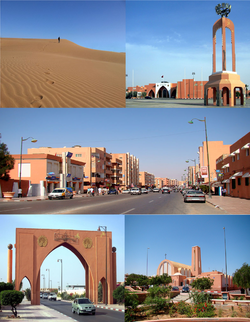
Back Laâyoune AF L'Aaiún AN العيون (مدينة) Arabic لعيون ARY العيون ARZ L'Aaiún AST Laayoune AVK Əl-Əyun AZ العیون AZB Эль-Аюн BE
Laayoune
العيون (Arabic) El Aaiún | |
|---|---|
City | |
 Left to right, top to bottom: Footprints on the sand, Place Mechouar, Street, Monumental Arch, Laayoune Cathedral | |
| Coordinates: 27°09′00″N 13°11′56″W / 27.15000°N 13.19889°W | |
| Non-self-governing territory | Western Sahara |
| Claimed by | |
| Controlled by | |
| Region | Laâyoune-Sakia El Hamra |
| Province | Laâyoune |
| Settled | 1934 |
| Founded | 1938 |
| Founded by | Antonio de Oro |
| Area | |
• Total | 247.8 km2 (95.68 sq mi) |
| Population (2014)[1] | |
• Total | 217,732 |
| • Density | 880/km2 (2,300/sq mi) |
| Time zone | UTC+01:00 (West Africa Time) |
| • Summer (DST) | (Not Observed) |
Laayoune[note 1] or El Aaiún[note 2] (Arabic: العيون, al-ʕuyūn [alʕujuːn], Hassaniyya: [ˈləʕjuːn] ⓘ, lit. 'The Springs') is the largest city of the disputed territory of Western Sahara, with a population of 271,344 in 2023.[7] The city is de facto under Moroccan administration as occupied territory. The modern city is thought to have been founded by the Spanish captain Antonio de Oro in 1938.[8] From 1958, it became the administrative capital of the Spanish Sahara, administered by the Governor General of Spanish West Africa.[9]
In 2023, Laayoune is the capital of the Laâyoune-Sakia El Hamra region administered by Morocco, it is still under the supervision of MINURSO, a UN mission.
The town is located south of the dry river of Saguia el-Hamra, where the old lower town constructed by Spanish colonists is located.[10] The St. Francis of Assisi Cathedral was constructed during the Spanish period and is still active with a few Catholic missionaries.
- ^ "Population Légale des Régions, Provinces, Préfectures, Municipalités, Arrondissements et Communes du Royaume D'Après Les Résultats du 2014" (in Arabic and French). High Commission for Planning, Morocco. 8 April 2015. Retrieved 29 September 2017.
- ^ "Laayoune". Lexico UK English Dictionary. Oxford University Press. Archived from the original on 2020-03-22.
- ^ a b "Laayoune". Merriam-Webster.com Dictionary. Merriam-Webster. Retrieved 17 August 2019.
- ^ "Laâyoune". Collins English Dictionary. HarperCollins. Retrieved 17 August 2019.
- ^ "el-Aaiún". Lexico UK English Dictionary UK English Dictionary. Oxford University Press.[dead link]
- ^ "El Aaiún". Collins English Dictionary. HarperCollins. Retrieved 17 August 2019.
- ^ "Population totale". siredd.environnement.gov.ma. Retrieved 2023-08-23.
- ^ Francisco López Barrios (2005-01-23). "El Lawrence de Arabia Español" (in Spanish). El Mundo. Retrieved 2013-02-11.
- ^ Norris, H. T. (1964). "The Wind of Change in the Western Sahara". The Geographical Journal. 130 (1): 1–14. doi:10.2307/1794260. ISSN 0016-7398. JSTOR 1794260.
- ^ Deubel, Tara F.; Boum, Aomar (2019). "The Rise of a Saharan City". Routledge Handbook on Middle East Cities. Abingdon: Routledge. doi:10.4324/9781315625164-18. ISBN 9781138650749.
Cite error: There are <ref group=note> tags on this page, but the references will not show without a {{reflist|group=note}} template (see the help page).

